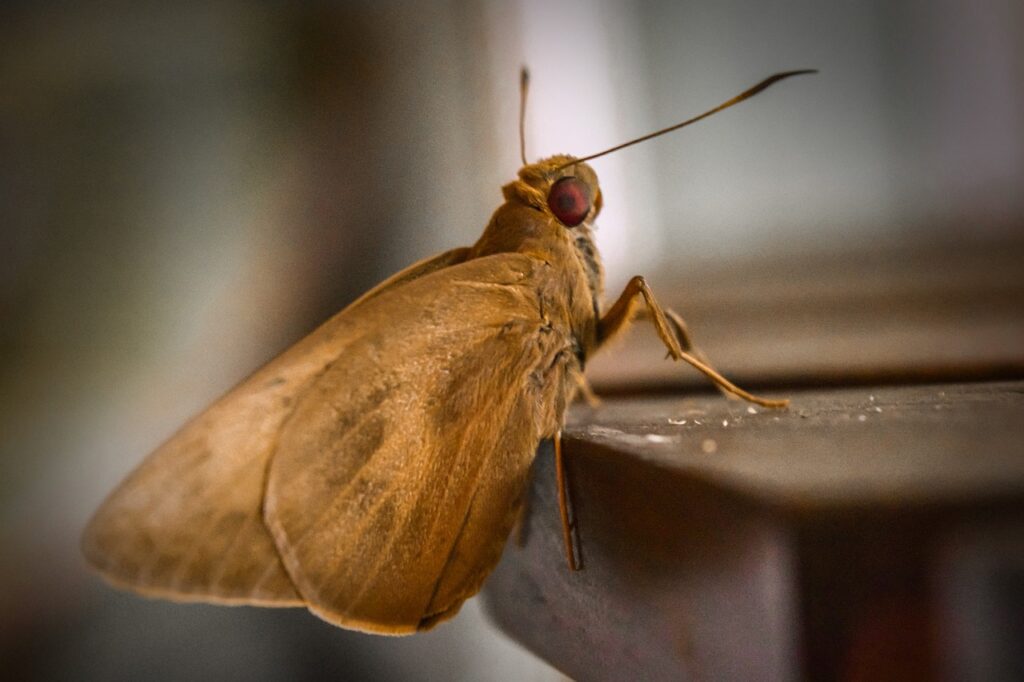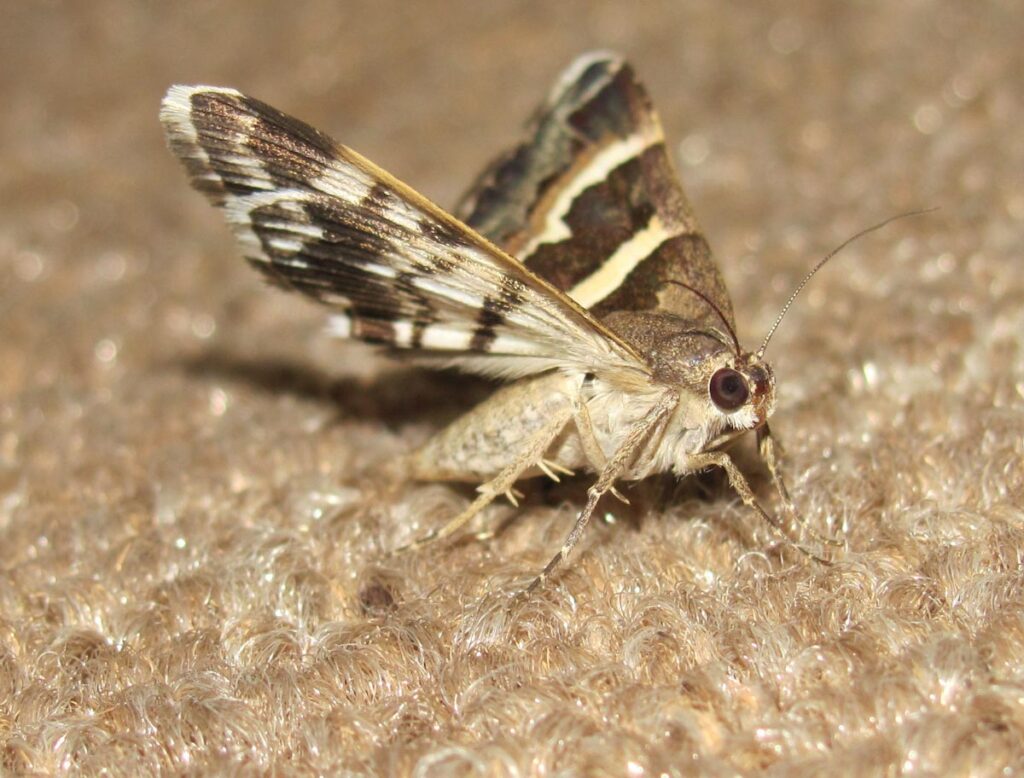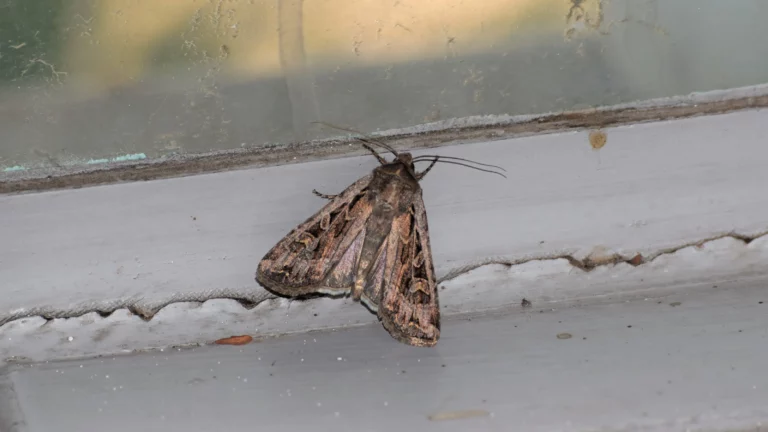Miller moths can be a nuisance when they congregate outside your house, but there are several steps you can take to help get rid of them or reduce their presence. Here are quick some effective methods to consider:
- Seal entry points with weatherstripping or caulk.
- Use yellow or sodium vapor lights to reduce attraction.
- Install screens on doors and windows.
- Maintain a clean yard and trim vegetation.
- Turn off outdoor lights when not in use.
- Use moth traps strategically.
- Encourage natural predators like birds and bats.
- Remove outdoor attractants.
- Use insecticides as a last resort, following instructions carefully.
- Consult a pest control professional if the infestation is severe.
How to seal entry points effectively?

By paying attention to these prevention and exclusion measures, you can significantly reduce the likelihood of miller moths entering your home and congregating around your property, making your environment less appealing to these insects.
Sealing Entry Points
- Identification: Start by inspecting your home for potential entry points. Check around doors, windows, vents, utility openings, and any gaps or cracks in the foundation.
- Caulking and Weatherstripping: Seal any visible gaps with caulk or apply weatherstripping to create a tight seal around doors and windows.
- Reinforcing Door Sweeps: Ensure that door sweeps are installed and in good condition to prevent moths from slipping under doors.
- Repairing Damages: Repair damaged screens, torn window seals, or any other structural issues that could serve as entry points.
Installing Screens on Doors and Windows
- Screen Types: Choose high-quality, fine-mesh screens that effectively block miller moths without hindering airflow.
- Proper Installation: Moreover, ensure screens are securely installed without gaps or tears. Pay attention to corners and edges where moths may find entry points.
- Regular Maintenance: Periodically inspect screens for damages and repair or replace them as needed. This is crucial to maintaining their effectiveness.
Using Appropriate Outdoor Lighting
- Light Color: Miller moths are attracted to bright white and blue lights. Replace these with yellow or sodium vapor lights, which are less attractive to moths.
- Motion-Activated Lights: In addition, consider installing motion-activated lights to reduce the amount of time lights are on. This minimizes the opportunity for moths to gather around the light source.
- Timers and Sensors: Moreover, use timers or light sensors to automatically turn off outdoor lights when they are not needed, particularly during the moth season.
Keeping Outdoor Areas Clean
- Vegetation Maintenance: Trim bushes, trees, and shrubs near your home. Miller moths are drawn to vegetation, and maintaining it can reduce their hiding spots.
- Weed and Tall Grass Removal: Remove tall grass, weeds, and overgrown areas in your yard, as these can provide hiding places for moths during the day.
- Debris Removal: Regularly clean up outdoor areas to eliminate potential moth attractants, such as fallen fruits, spilled food, or decaying organic matter.
What are the benefits of trimming vegetation?
Trimming vegetation, keeping your lawn well-groomed, and eliminating hiding spots will help reduce the population of moths in your outdoor space, making it less likely for them to congregate around your house.
Trimming Vegetation
Identify Problematic Plants: Begin by identifying plants that are particularly attractive to miller moths. These may include dense shrubs, tall grasses, and flowering plants.
Pruning: Trim and prune vegetation near your home to reduce its density. This not only removes hiding spots for moths but also makes your yard less appealing to them.
Spacing: Moreover, ensure there’s adequate spacing between plants, allowing for better air circulation and reducing the ideal habitat for moths.
Removing Tall Grass and Weeds
Regular Mowing: Keep your lawn well-maintained by mowing it regularly. Moths are less likely to congregate in short grass.
Weed Control: Implement a weed control plan to prevent the growth of tall weeds. Moths often use tall weeds as resting places during the day.
Mulching: Apply mulch around plants and in garden beds to deter weed growth and create an environment less favorable to moths.
Reducing Moth Hiding Spots
Inspect Yard: Conduct a thorough inspection of your yard to identify areas where moths might hide during the day. These spots can include dense foliage, cluttered storage areas, or piles of debris.
Declutter: Remove unnecessary items from your yard and storage areas. Moths can seek shelter in stacks of firewood, old equipment, or unused furniture.
Proper Storage: Store items neatly in sheds or garages, and seal storage containers tightly to prevent moths from accessing them.
How do motion-activated lights reduce moth attraction?
By using motion-activated lights and turning off unnecessary lights at night, you can minimize moth attraction.
Using Motion-Activated Lights
Functionality: Motion-activated lights are equipped with sensors that detect movement within a certain range. They activate the light only when motion is detected.
Advantages: In addition, these lights are beneficial for two reasons. First, they save energy because they are not continuously on. Second, they reduce moth attraction since they only illuminate when needed.
Placement: Install motion-activated lights strategically around your property, focusing on areas where moths are particularly problematic, such as entryways or gathering spots.
Turning Off Lights at Night
Purpose: Miller moths are attracted to artificial light sources at night. Turning off outdoor lights when they are not necessary can significantly reduce the number of moths congregating around your house.
Light Sensors and Timers: Install light sensors or timers to automate the process of turning off outdoor lights. These devices can ensure that lights are off during the late evening and overnight when moths are most active.
Curtains and Blinds: Indoors, use curtains or blinds to block indoor lights from escaping outside. This can prevent moths from being drawn to the light from within your home.
How can moth traps be strategically placed for effectiveness?
Strategically placed moth traps can help reduce the moth population and provide valuable insights into the types of moths present in your area.
Purpose and Benefits of Moth Traps
Attract and Capture: Moth traps are designed to attract moths with a light source and trap them using a sticky or adhesive surface. Some traps also use pheromone lures to attract specific moth species.
Benefits:
Reduction in Population: Moth traps can significantly reduce the number of moths in the vicinity.
Monitoring: In addition, they serve as a valuable tool for monitoring moth activity and identifying the types of moths present.
Non-Toxic: Moth traps are generally non-toxic and safe for the environment, making them an eco-friendly option.
Types: There are various types of moth traps available, including electric traps, glue traps, and pheromone traps, each with its own advantages.
Strategic Placement of Traps
High-Risk Areas: Position moth traps in areas where moths are most problematic, such as near outdoor lights or entry points.
Monitoring: Initially, place traps in multiple locations to assess moth activity. After identifying hotspots, concentrate the traps in those areas for more effectiveness.
Height: Hang traps at a suitable height, often around eye level, to ensure they are within the moths’ field of attraction.
Regular Maintenance: Check traps regularly to replace sticky surfaces or pheromone lures as needed. Clean traps to maintain their effectiveness.
How to attract birds and bats to control moths?

Encouraging natural predators like birds and bats is an eco-friendly way to control moth populations, contributing to a balanced ecosystem.
Attracting Birds and Bats
Provide Nesting Sites: To attract birds, consider installing birdhouses, nest boxes, or bird feeders in your yard. Different bird species have varying preferences, so research which types are common in your area.
Water Sources: Birds are more likely to visit when water is available. Install a bird bath or small pond to provide drinking and bathing opportunities.
Bats: To attract bats, consider putting up bat houses. Bats are nocturnal and can consume a large number of moths during their nightly foraging flights.
Native Plants: Plant native trees and shrubs that produce berries or fruits that attract birds. Native plants also support the local ecosystem and provide natural food sources.
Role of Natural Predators in Controlling Moths
Birds: Many bird species, such as swallows, warblers, and nighthawks, feed on flying insects, including moths. They can help keep moth populations in check.
Bats: Bats are voracious insect-eaters, and some species are known to consume large quantities of moths during their nightly hunts. They play a crucial role in controlling moth populations.
Ecological Balance: Encouraging natural predators contributes to a healthy ecosystem by maintaining a balance in insect populations. This reduces the need for chemical interventions.
How to use insecticides safely and responsibly?
When considering chemical solutions, it’s essential to weigh the potential environmental impact and use them as a last resort, following responsible application practices to minimize harm to non-target organisms.
Considerations Before Using Insecticides
Environmental Impact: Understand the potential environmental consequences of using insecticides. Some chemicals can harm beneficial insects, wildlife, and plants.
Moth Species: Identify the specific moth species causing the problem. Different species may respond differently to insecticides, and using the wrong type may be ineffective.
Application Timing: Apply insecticides during the moth’s active hours, typically at dusk or dawn, when they are most active and exposed.
Follow Label Instructions: Always read and follow the label instructions of the chosen insecticide. Use the recommended safety precautions and dosage rates.
Selective Insecticides: If possible, choose insecticides that are selective and target moths specifically, minimizing harm to other non-target organisms.
Safe and Responsible Use of Insecticides
Localized Application: Apply insecticides only to affected areas rather than broad-spraying your entire yard. This minimizes the impact on non-target organisms.
Personal Protective Equipment (PPE): Wear appropriate protective clothing, gloves, and masks when handling and applying insecticides.
Proper Storage: Store insecticides securely in their original containers, away from children and pets, and follow local regulations for disposal.
Alternative Methods: Consider using non-chemical methods first and resort to insecticides only when other approaches have proven ineffective.
Professional Assistance: If you are unsure about using insecticides or if the infestation is severe, consult a pest control professional who can apply them safely and effectively.
FAQ’s
What is the best repellent for Miller moths?
One effective repellent for Miller moths is citronella-based sprays or candles.
How do I get rid of moths outside?
To get rid of moths outside, consider strategies like sealing entry points, using motion-activated lights, and maintaining a clean yard.
How do you kill Miller moths?
You can kill Miller moths by using a vacuum cleaner, flyswatter, or insecticide spray.
How do you get rid of Millers naturally?
Natural methods include attracting birds and bats, using moth traps, and maintaining a well-trimmed yard to reduce hiding spots.
What smells do moths hate?
Moths dislike strong-smelling herbs like lavender, cedar, and mint. Placing sachets or cedar blocks in your closets can help deter them.
Is there a spray to keep moths away?
Yes, you can use moth repellent sprays, which often contain essential oils like lavender or cedarwood, to keep moths away from clothing and storage areas.
FInal Words
In conclusion, when dealing with miller moths outside your house, there are several effective strategies you can use.
First, make sure to seal any openings like cracks and gaps where moths can get in. Installing screens on doors and windows is a good way to keep them out too.
Use outdoor lights wisely by switching to yellow or sodium vapor lights, and consider motion-activated lights to reduce moth attraction. Keeping your yard clean and well-maintained is also crucial. Moth traps can be a big help, especially when placed strategically.
Encouraging natural predators like birds and bats can work wonders. And remember, only use insecticides as a last resort, and always follow safety guidelines.
By following these steps, you can make your home and yard less inviting to miller moths and enjoy a more peaceful living space.

